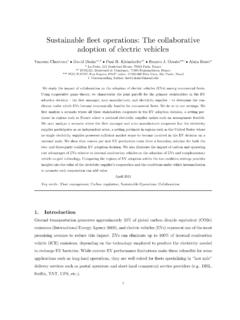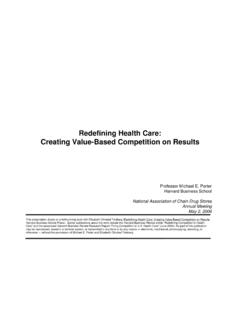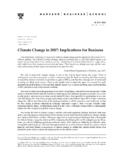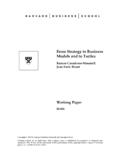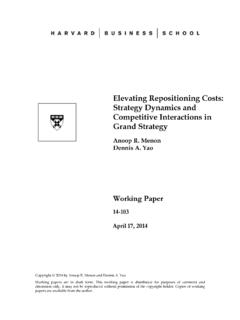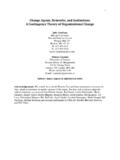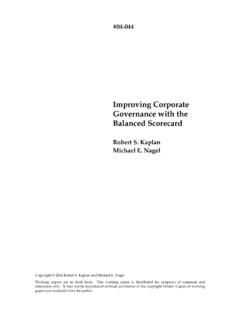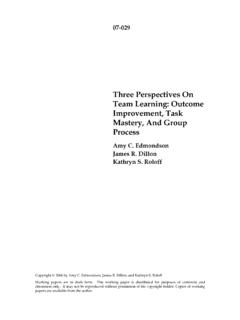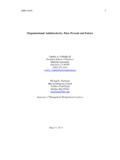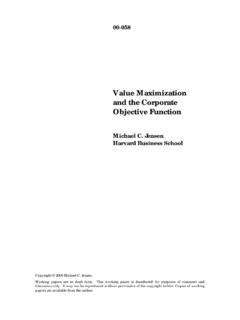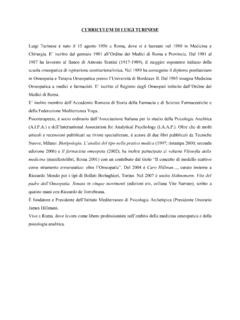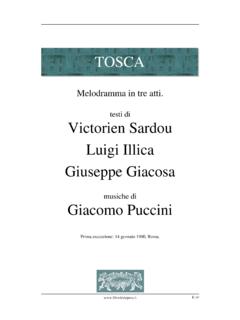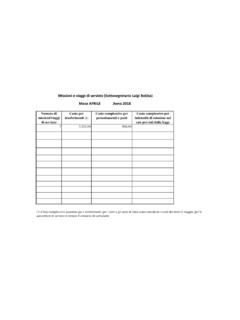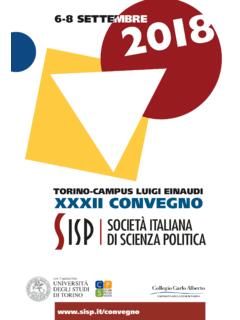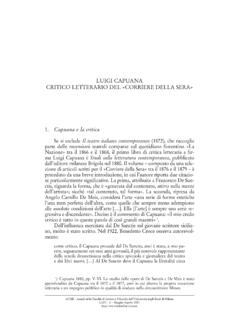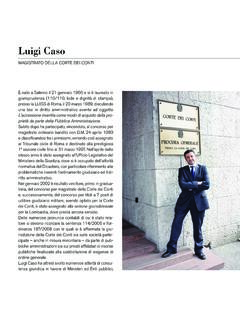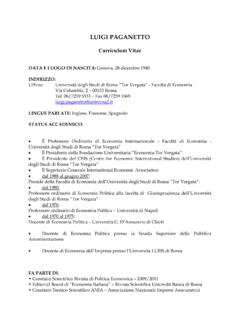Transcription of What Do CEOs Do? - Harvard Business School
1 Copyright 2011 by Oriana Bandiera, luigi Guiso, Andrea Prat, and Raffaella Sadun Working papers are in draft form. This working paper is distributed for purposes of comment and discussion only. It may not be reproduced without permission of the copyright holder. Copies of working papers are available from the author. what Do CEOs Do? Oriana Bandiera luigi Guiso Andrea Prat Raffaella Sadun Working Paper 11-081 what Do CEOs Do? Oriana BandieraLondon School of EconomicsLuigi GuisoEuropean University Institute and EIEFA ndrea PratLondon School of EconomicsRa aella SadunHarvard UniversityFebruary 25, 2011 AbstractWe develop a methodology to collect and analyze data on CEOs time use. The idea sketched out in a simple theoretical set-up is that CEO time is a scarce resource and itsallocation can help us identify the firm s priorities as well as the presence of governanceissues.
2 We follow 94 CEOs of top-600 Italian firms over a pre-specified week and record thetime devoted each day to di erent work activities. We focus on the distinction betweentime spent with insiders (employees of the firm) and outsiders (people not employed bythe firm). Individual CEOs di er systematically in how much time they spend at workand in how much time they devote to insiders vs. outsiders. We analyze the correlationbetween time use, managerial e ort, quality of governance and firm performance, andinterpret the empirical findings within two versions of our model, one with e ective andone with imperfect corporate governance. The patterns we observe are consistent withthe hypothesis that time spent with outsiders is on average less beneficial to the firm andmore beneficial to the CEO and that the CEO spends more time with outsiders whengovernance is poor.
3 We thank seminar participants at Catholic University of Milan, Columbia University, EEA Meetings, Harvard Business School , Imperial College, IMT Lucca, LSE, MIT, New York University, NIESR, UniversitatPompeu Fabra, Stockholm (IIES), and the University of Sussex for useful comments. We are grateful toTito Boeri, Daniel Ferreira, Luis Garicano, Steve Pischke, Imran Rasul, and Fabiano Schivardi for usefulsuggestions. This research was made possible by generous funding from Fondazione Rodolfo management has been at the core of the research on management for almost fifty Drucker (1966) makes it the centerpiece of his celebrated book on e ective management: E ective executives know that time is the limiting factor. The output of any process is setby the scarcest resource.
4 In the process we call accomplishment , this is time. More recently, the importance of time constraints for people at the top of organiza-tional hierarchies has been recognized by a number of economic models, like Radner and VanZandt s work on hierarchies (surveyed in Van Zandt, 1998), Bolton and Dewatripont (1994),and Garicano (2000). Intellectual tasks information processing in Radner-Van Zandt, com-munication in Bolton-Dewatripont, problem solving in Garicano require managerial time,which is particularly scarce at the top of the a consequence, a key question in organization economics is whether and how managersallocate their time to maximize firm performance. The theoretical and practical interest,however, are not matched by adequate empirical evidence, as firm datasets typically containno information on managerial time use, while existing studies of managerial time use aremostly based on very few observations and have not been matched to firm level paper makes a step towards filling this gap by developing a methodology to system-atically collect information on how CEOs allocate their time between di erent work develop a time-use diary for CEOs and we use it to record the time allocation of a sampleof 94 CEOs belonging to leading Italian companies in various industries over a pre-selectedwork week.
5 A minimalistic model of managerial use of time guides our interpretation of ob-served di erences in time allocation patterns, and how these are related to the firms prioritiesand to di erences between the firms and the CEOs collect the time use data, we ask the CEO s personal assistant (PA) to keep a diary ofthe activities performed by the CEO during a pre-specified week (from Monday to Friday).The PA has full information on the CEO s schedule and he/she has a good understanding ofthe functions of the people that his/her boss interacts PA reports overall workingtime and records in a diary all the activities of the CEO that last longer that 15 minutesdetailing their characteristics, in particular information on other operationalize the concept of time allocation, we group activities according to whetherthey involve employees of the firm (insiders) or only people external to the firm (outsiders).
6 Insiders are listed by functional area, for instance finance, marketing, or human Sadowski, Jack Welch s long-term PA, makes this abundantly clear: For more than fourteenyears, I ve been human answering machine, auto dialer, word processor, filtering system, and fact checker;been a sounding board, schlepper, buddy, and bearer of good and bad tidings; served as a scold, diplomat,repairperson, cheerleader and naysayer; and performed dozens of other roles under the title of assistant . 2 Outsiders are grouped in categories CEOs normally interact with, for instance suppliers,investors, or consultants. The insider/outsider classification is ideal for our purposes for tworeasons. First, it captures the essence of the CEO s job: The CEO is the link between theInside that is the organization, and the Outside of society, economy, technology, markets, andcustomers (Drucker, cited in Lafley 2009).
7 Second, it is a dimension over which the CEO sand the firm s interests might be misaligned. As a matter of fact, the optimal inside/outsidebalance is the subject of controversy in the management, finance and economics literature. Atone end of the spectrum, a widely held view is that since the CEO is the "public face" of thecompany, spending time outside the firm is an important (if perhaps not the most important)role of the the other end, however, an increasingly popular view points out thattime spent with outsiders might mostly benefit the CEO without contributing to creatingvalue for the firm. Khurana (2002), for instance, argues that CEOs have strong incentivesto seek visibility, by cultivating personal connections with influential Business leaders.
8 Inline with this, Malmendier and Tate (2009) show that when their power vis-a-vis the firmincreases, CEOs spend more time outside the firm in activities, such as writing books andplaying golf, and that this shift in activities does not contribute to firm s data reveal that, as expected, CEOs spend the majority of their time with otherpeople (85%). Of these most are employees of the same firm, but many are not. On average,CEOs spend 42% of their time with insiders only, 25% with both insiders and outsiders and16% with outsiders alone. More interestingly, these averages hide a great deal of heterogeneity,both in terms of number of hours worked and time allocation. A majority of CEOs spendvery little time (less than 5 hours per week) alone with outsiders, but over 10% of themspend over 10 hours a week.
9 Our empirical analysis is aimed at making sense of the wideheterogeneity on this dimension of time allocation the implication of di erent time allocation choices - and in particular the di er-ential impact of time spent with insiders vs. outsiders - is a priori ambiguous, we developa minimalistic model of managerial time allocation that allows us to distinguish productiveactivities from activities that mostly confer private benefits to the CEO. We use this frame-work to shed light on whether time with insiders and outsiders can be interpreted along theselines. In our model, the CEO chooses how much time to devote to a number of possible2 Procter & Gamble s CEO A. G. Lafley (2009) views the link with the outside as the raison d tre of thetop executive: The CEO alone experiences the meaningful outside at an enterprise level and is responsiblefor understanding it, interpreting it, advocating for it, and presenting it so that the company can respond inawaythatenablessustainablesales,profit ,andtotalshareholderreturn(TSR)growth.
10 3 Khurana (2002) s view is that the market for CEOs is deeply flawed. The search for external, charismatic corporate saviors leads boards and the executive search companies they employ to give their preferenceto highly visible personalities that can more easily be "sold" to the firm shareholders. In turn, this creates anincentive for CEOs to seek visibility, by cultivating personal connections with influential Business activities, or to leisure. Each of the work activities yield non-negative benefitsto the firm and to the CEO. For instance, networking with clients might increase the firm ssale but also increase the chance that the CEO is o ered a better job in the future. Supposeactivities can be roughly divided into the ones that benefit mostly the firm and those thatbenefit mostly the CEO.
